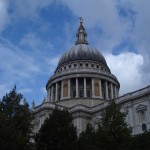Entries from August 2009
August 31st, 2009 · 1 Comment
Anyone who has had a class with Professor Maggidis will know the Greek side of the Elgin Marble story quite well. According to him, the elaborate carvings were forcifully taken from the sides of the Parthenon by Lord Elgin, who did not have a right to them. The British Museum told a very different story. The current position of the Museum is that the Marbles were removed legally with the permission of the Ottoman authorities. However, the Greeks were not asked their opinion. Since the early 1980s, the Greek government has argued for the return of the Marbles to Athens. The British Museum believes that they are “a unique resource for the world: the breadth and depth of its collection allows the world to re-examine cultural identities and explore the complex network of interconnected world cultures.” This same mission statement also applies to the other artifacts of the Museum. However, “the Trustees’ view [the Elgin Marbles] are part of everyone’s shared heritage and transcend cultural boundaries.” To them, the splitting of the Parthenon Marbles between six major museums of the world allow for different interpretations to be examined. We are not so sure. What gives the British Museum the right to possess the sculptures after the Ottoman Empire dissolved and the Greek government asked for them back? Would they appreciate capstones from Stonehenge appearing in the Louvre or another major art museum of the world? Where’s the line between exhibiting cultural artifacts and claiming them as your own? You might ask us if we benefited from seeing the Elgin Marbles for free in the British Museum. Of course we did.
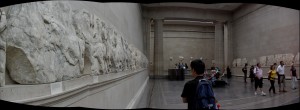
The Elgin Marbles in the British Museum - should they be here?
Continuing on our critical journey through the British Museum, we were struck by the assumption that every culture that the British encountered became part of the British cultural heritage. This was especially apparent in parts of the former Empire. This attitude was even expressed in places that dissolved from the Empire centuries ago. For example, after Buffalo Bill’s Wild West show in London, Queen Victoria was talking to Black Elk (a Native American chieftain) and said “I wish that I had owned you people, for I would not carry you round as beasts to show the people.” Although Queen Victoria probably meant well, this statement is preposterous! We think she meant that she didn’t approve of the Native Americans parading around making a parody of their culture for the entertainment of others. However, there seems to be a discrepency when looking at the colonies under Victoria’s control (India, Hong Kong, Africa, etc.).
The British Museum has made us rethink who should have posession over a cultural artifact. We believe that it’s a major grey area. Does a British archeologist digging in France have the right to the objects found, or does the French government? There are too many variables. We enjoyed almost everything we saw at the Museum and it was a great learning experience, but we couldn’t help but feel an uneasy sense of awe in the rooms where the decoration was in Britain, but the structure was elsewhere in the world.
Tags: Bureucracy · Grace · Kelley · Museums
August 31st, 2009 · 1 Comment
Imagine being in a place where all of your passions interconnect, where your heart races, you forget to breathe, your interest peaks. I have to remind myself to breathe today upon entering The Victoria and Albert Museum directly from stepping off the tube station into the museum. Deep breaths, I say to myself when I see Louis Richard Garbe’s piece, Primavera. Deep breaths I tell myself when I see the dresses by Catherine Walker worn by Princess Diana. Deep breaths when I stumble upon Joan Rhodes’s theatrical costumes, Reg Wilson’s performance photographs, sight of jewelry worn throughout centuries, breath taking carpets and other Islamic crafts. Inspiration surrounds me everywhere.
“Sculpture is a three-dimensional object with a message…”
Bob Brendle
After examining the sculptures showed at The Victoria and Albert Museum, I felt the messages sculptures were illuminating. A child and a mother, the look they share, the connection and love that exists between them. A cupid slyly planning his next attack, by preparing a bow and arrow to shoot at a King. Two soldiers fighting, the anger and determination in their stony eyes. Moving on to Islamic carpets, I am reminded of my own culture, of beautifully woven rugs and elaborately decorated vases. Not having a map at hand, I began walking through the museum, stumbling upon the silver lined plates and crafts of Paul de Lamerie and the portion of the museum which holds theatre exhibitions. Ranging from costumes worn by Joan Rhodes to the construction of the stage and backstage look at the performances in 18th Century, I was pleasantly surprised. Although the museum provided satisfaction to all of my senses, I was on the quest to finding two of my upmost passions, photography and jewelry. As I finally stepped through the doors of jewelry exhibit, I was blinded by diamonds, gold, silver, crowns, pendents. I thought “This is what heaven must look like” (at least in my world). Behind glass windows, jewels worn in 1500’s lined against the walls ranged to the present trends in jewelry. Inspiration surrounding me everywhere, I headed towards the photography section. As I entered, I was overpowered by Charles de Temple, E.R. Nele, Roger Moris and many more. The museum began acquiring pieces in 1852 and now I was in the presence of classic as well as contemporary works. One piece that particularly caught my attention was of a “Shell-shocked Soldier, Hue” by Don McCullin in 1968 taken during the Vietnam War. The simplicity yet so much emotion behind the piece and the soldier’s eyes is indescribable. My passion has ignited. Although I have always captured my surroundings and emotions through a camera lens, seeing the photography exhibit has encouraged me and made me hope that one day I can also show my work. Who knows what holds in the future for me and my photography. But for now I am planning on returning to The Victoria and Albert Museum and exploring other photography exhibitions in London such as Tom Hunter’s “A Journey Back” shown close by on Oxford Street.
I am inspired. 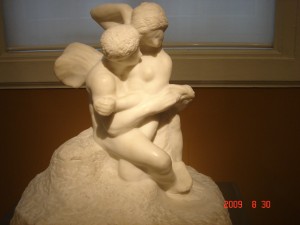
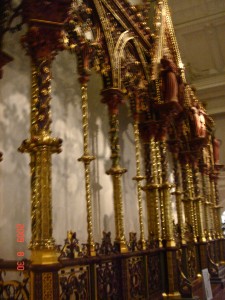
Tags: Jeyla · Museums
-
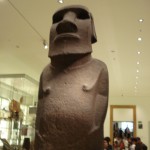
-
Part of the African Exhibit in the British Museum
-
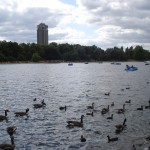
-
Hyde Park Waterfront
-
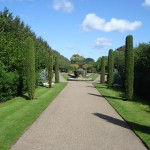
-
Regents Park
-
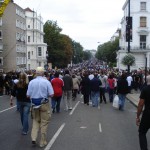
-
Walking towards the Notting Hill Carnival
-
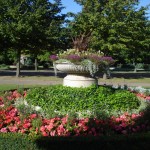
-
Flowers in Regents Park
-
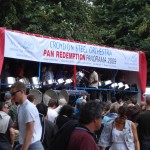
-
Steel Drum Ensemble in Hyde Park
After a busy few days nothing could be more relaxing than a day spent in a park…well two actually. In the morning we started out the day with a class in beautiful Regent’s Park located just a few minutes away from the Arran House. Our classroom discussion centered on two very different topics; Virginia Woolf’s Mrs. Dalloway and “the Blitz”. Despite the difference in subject material both conversations brought up some interesting points and I found myself seeing new perspectives on a lot of things both from my peers and from Professor Qualls.
Maybe it was just the time of day (early on a Saturday morning) but Regent’s Park had a very quiet, quaint feel to it. I realize there is still much of the park that I need to explore but from what I saw with the beautiful flower gardens and shrubbery and wide pathways it seems like it would be a great place to go for a run or relax with a book.
After a great lunch at an affordable mediterranean sandwich place with the three Andrew’s I headed out with Alli, Sarah, Mara and Kim to continue the preliminary work for our group project. We headed to Hyde Park, a place we knew would occupy most of our afternoon. Hyde Park immediately reminded me of Central Park more than any other green space I had visited in London thus far. We decided to wander towards the long expanse of water known as “the serpentine” running through the middle of the park. Along the way we passed a large group of people playing steel drums and moving to the music. The park felt alive and it was the first green space that I felt like was being utilized for large group purposes.
The water was filled with waterfowl of all shapes and sizes. There were ducks, swans and geese just to name a few. We saw that there were opportunities to rent boats for seven quid and we thought it would be a great idea to come back and do that another time. After crossing a bridge we came upon a Peter Pan statue. This was a perfect group photo op. After sitting down and taking in the scenery for a bit we headed back to the park exit content with our decision to choose Hyde as the basis for our group’s walking tour.
Sunday was another busy day. Aidan, Brandon and I headed to the British Museum where we attempted to get through the whole thing. This did not happen. We did end up getting through the Middle East, Greek, Roman, African and North American exhibits however. All in all not bad for one day. We also viewed a special exhibit the museum was featuring about living and dying. This certainly defied the plain yet effective pattern the British Museum has going for it. In one section of this exhibit there was a woman and a man featured. There was a long tapestry made out of all of the pills these two people took throughout their lifetime. Everything from vitamins to birth control to painkillers for arthritis were featured in this amazing display. There was also a display done on how different cultures around the world react to life and death and even how they bury their dead. Not only was this a fascinating exhibit but it added a whole new wrinkle to the British Museum.
After a quick break Brandon, Aidan and I decided it would be interesting to head over to Notting Hill where the annual Notting Hill Carnival was taking place. We had been warned multiple times to bring only the bare minimum and be extremely careful with our belongings. We had also been warned about the huge crowds and lack of personal space we would encounter. Unfortunately for us nothing could have prepared us for what we saw once we got off of the Notting Hill tube stop. Endless masses of humanity were walking. We had no idea where their final destination was so we simply followed. Eventually the street opened up and even more people appeared. There were floats making their way down the streets, loud music blasting and people dancing and singing. It was unlike anything I had ever seen before. People that lived in the area were charging others money to use their bathroom. There were no trash cans so litter was piling up in the streets. Other folks were walking around with coolers of beer and soda in an attempt to make a little money. Although large crowds are not my thing and I do enjoy my personal space going to the carnival was an eye opening experience. As Americans sometimes we are so driven to achieve a certain goal, meet a certain deadline, fulfill a certain quota. There has to be some sort of end reward for everything. The nice thing about the Carnival and the thing that I struggled to understand the most is that there was really no point to it. Each and every person made their experience what they wanted it to be. Some used it to express their cultural heritage, some used it as an excuse to hang out with friends or family and some simply used it to get drunk. The bottom line was that everyone was there and having a good time in their own right.
After navigating our way through masses of people we veered off the main path a little bit and found a street with some places that looked like they would be good to eat at. After completing our meals we decided we should start finding a way out of the carnival knowing that it would take us a very long time to navigate out of the crowd. For a while it seemed that no matter where we walked there were people in every direction with no apparent end in sight. Finally we approached a street corner and across the street there was traffic, the first sign that the festival had an end. We attempted to navigate our way to Paddington Station but after a decent walk opted to take the bus to Great Portland Street instead and walked back from there. The entire journey took less time than I thought it would and we were back at the Arran House by a little after 6.
As I continue to explore here I feel like I am getting a better sense of all the different expressions London has to offer. I’ve seen it’s artsy side, it’s serious side, it’s fun side and it’s theatrical side. What will I find next?
Tags: Henry · Museums
I love museums. I like to put my ipod on and wander around alone, allowing myself to really get the full experience of the art. It feels like I’m connecting to not only the piece of art itself, but to the artist and his or her experiences and emotions.
On Saturday, Amy and I took the tube to Charing Cross to visit The National Gallery. There we proceeded to immediately get lost in the extensive building, but we weren’t complaining. We wandered through room after room that held amazing works by Rembrant, Van Gogh, Monet, Leonardo da Vinci, Cezanne, and Turner, just to name a few of my favorites. I compared this museum to the Met in NYC: both are enormous, well cared for, and very popular. However, I noticed a key difference. This difference is simply that most museums here are free, with a just a suggested donation, unlike the Met which charges 10$ per visitor. I love that England honors the historical and cultural value of artwork by making it accessible to the general public. Not only could I observe famous works of art, but I could also examine the evolution of religious practices, social castes, daily life, and even fashion free of cost.
This is a pretty good segway into discussing the museum I visited today: the Victoria and Albert Museum, commonly referred to as the V & A. As a small group, we left from Euston Station to take the central line directly to South Kensington where the tube conveniently led us straight into the museum.
At first, I really didn’t know what to expect of this experience…I mean, I know very little about fashion and I simply wasn’t sure how I was going to be able to relate to the displays.
Yet, as is often the case, I was pleasantly surprised.
I walked into a room filled with some of the most beautiful sculptures I have ever seen. Though I had never heard of most of the sculptors, I was able to get really close to each of the statues and really examine the detail and expression in each.
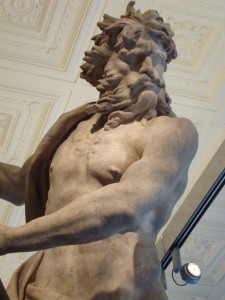
With my head phones in and the world tuned out, I strolled around. There was a huge exhibit on the evolution of clothing, another on shoes & accessories, another on fashionable metal-ware (pots, religious idols, masks, etc).
It was really cool to see how our everyday lives have been affected by the trends of the past. We often hear that things are “out of style” or “not in fashion anymore” but have we really stopped to contemplate what that means? Fashion is constantly fluctuating and changing and all of us, (whether you consider yourself fashion forward or not), are players in this game. We ourselves are walking works of art, displaying the genius of designers as they mold trend after trend, mixing past and future to create something entirely new. And that, at least to me, is fascinating. The thought that I am connected to the past through the evolution of fashion really intrigues me and I would never even have noticed this unless I’d visited the V& A museum!
Another exhibit that I thought was amazing, literally AMAZING, was located in the main lobby of the museum. It was called “Telling Tales; Fantasy and Fear in Contemporary Design” created by international designers Tord Boontje, Maarten Baas, Jurgen Bey and Studio Job who were all inspired by the classic fairy tales which they then translated into their construction offurniture. I know it sounds almost comical (like really, how can furniture be at all interesting) but I’d never seen anything like it. I posted a link a little further down that gives you a little tour.
Also in this exhibit was a frightening, but brilliant, room that entitled “Heaven and Hell”. I won’t give all of it away because I cannot adequately describe it, but the link below also can give you an idea of what to expect. However, I will say this, the lighting, color, back drops, music, and the positioning of the art are all major contributors to the overall effect of the art and are carefully constructed by the artists/museum staff. Basically, see it in person because you won’t regret it.
http://www.vam.ac.uk/microsites/telling-tales/exhibition.html
This exhibit only lasts until October 18th, and I suggest everyone see it while here. Truly, both the National Gallery and the V&A are exceptional and I really enjoyed having the opportunities to both observe and reflect on my experiences.
Tags: Maddie · Museums · Uncategorized
August 30th, 2009 · 1 Comment
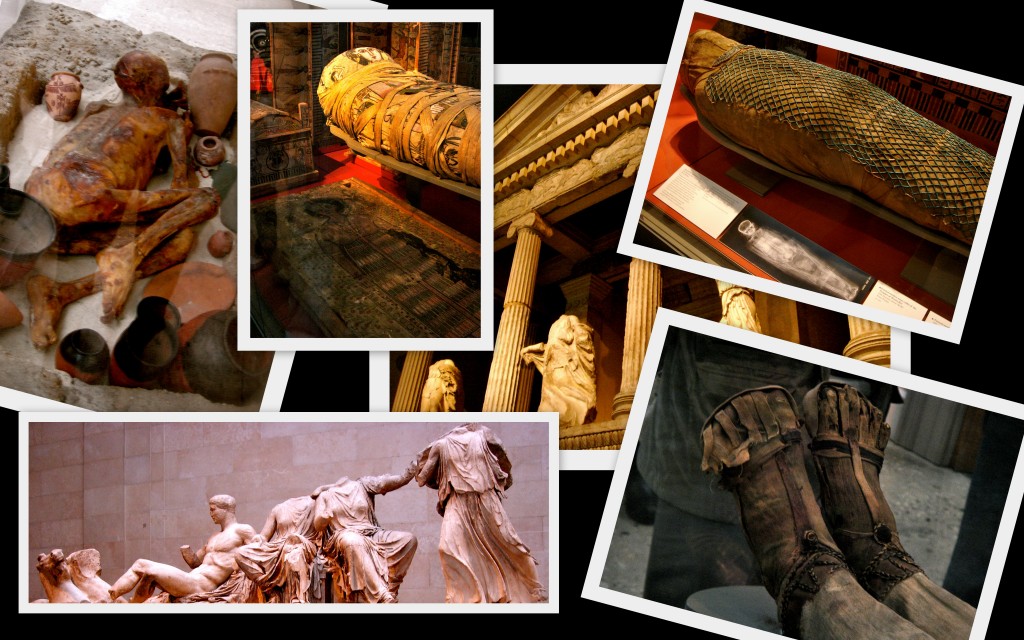
[Author’s note: I am a lover of museums, I enjoy the idea of presenting something for public admiration, yet the following post is a type of critique directed towards museum culture. The questions I pose seek responses and if you can and are willing to I am more than happy to receive responses and to discuss comments and ideas.]
Every civilization constructs themselves in unique ways, develops rituals, cultural symbolisms and folklore depending on the values, morals and believes of either a powerful minority or the general population. When I visited the British Museum today I was at awe at the number of Egyptian objects on display and could not help but to inquire about their present state. I know this is a museum and the point is to display objects of interest to the general public, after all that is how revenue is made and popularity is obtained, the “weirder” the object the more people that want to come see, but why? I realized that museums practice a form of cultural fragmentation, they present to the audience a piece of a culture/civilization, the one that we (as the audience) will be most intrigued by; again, but why? why are we always fascinated with that which is different from the things that we know (as “normal”)? What makes us so superior that we have taken the right to place other cultures on display as if they were commodities? Thousands of years displayed in one room, objects preserved for a lifetime and …mummies on display? Whatever happened to resting in peace?
If Egyptians believed in placing specific objects in the tombs of their pharaohs for the after life then guess what, we have totally screwed up thousands of years of ritualized mummification for the sake of cultural representation. For as silly as this may sound I was a bit saddened to realize that if Cleopatra came back in her after life she would have no wealth, it has been divided among different museums and collectors all overt eh world. Her mummy was assigned a resting place, a burial ground, for a reason, and by removing her from that environment we have damaged the fabric of one of the world’s most intricate civilizations. How dare we disrupt the living dead? How dare we destroy sanctuaries, transport them across the globe, and study them as if they were meant to be objectified in the first place.
Although, I was extremely impressed at the sculptures of the Parthenon (located at the exhibit on Greece at the British museum), once again I asked myself: Why are these magnificent structures here? Why are they not at the Parthenon where they belong? Later in the day I learned from on of my classmates that it’s a complicated history which most of us know nothing of. She explained to me how parts of the Parthenon were being stolen from their original site, and so someone “rescued” pieces in order to preserve what was left of it (these are some of the pieces on display). Ok, just maybe some of the objects displayed are righteously justified, but my questions still stand: why are we always fascinated with that which is different from the things that we know (as “normal”)? What makes us so superior that we have taken the right to place other cultures on display for our own leisure?
The questions rumbling through my mind make me think back on my Workshop in Cultural Analysis class last semester (at Dickinson) where we discussed issues with cultural representation, fragmentation, fetishism, commodity culture, among others. In this class I wrote a paper in which I argued that much of the discourse we know as “truth” (regarding the representation of different cultures) is based on the believes of a powerful minority. In the words of Bell Hooks (author of “Teaching to Transgress” and “Ain’t I a woman,” among others):
Within commodity culture, ethnicity becomes spice, seasoning that can liven up the dull dish that is mainstream white culture. Cultural taboos around sexuality and desire are transgressed and made explicit as the media bombards folks with a message of difference… bringing to the surface all those “nasty” unconscious fantasies and longings about contact with the Other embedded in the secret (not so secret) deep structure … In many ways it is a contemporary revival of interest in the “primitive.”
Even though the quote above speaks better to a more sexualized commodification and/or fragmentation of cultures it is relevant in multiple other ways. As a superpower Britain (as well as the US) have been the “main dish” seeking “spice” to “liven [themselves] up.” Both predominantly “white” civilizations (UK and US) have sought to explore and display the “other” in order to maintain themselves as the “us.”
The questions remain, why display mummies when they were not meant to be exhibited (all over the globe) in the first place?Why do we commodify other cultures, fragmentize them and appraise only a part of them (the part that has been given to us)? Again, every civilization constructs themselves in unique ways, develops rituals, cultural symbolisms and folklore depending on the values, morals and believes of either a powerful minority or the general population. What are we constructing that will be on display a thousand years from now? Would you like to see the complexities of your life minimized to a single cardboard wall (or a short movie clip), on some museum, set up for judgement? Would you like your body to be preserved, put up for auction, displayed on a gallery without your consent? Think about it, how would Cleopatra feel if she was to rise from the dead to tomorrow to find herself in a glass box, on a different continent, far from anything know, separated from her wealth and objects provided to her inside her tomb upon her death?
“A culture is made– or destroyed– by its articulate voices” (Ayn Rand, Russian born American writer and novelist).
Tags: Flow · Uncategorized
August 30th, 2009 · 1 Comment
Today Sarah, Chelsea and I made a journey to the Victoria and Albert Museum. Upon immediately entering the V&A, we noticed that it was going to be a hodgepodge of all sorts of items. The first room we entered featured various nudie sculptures that caught our attention. Then to our right we noticed the “Fashion” exhibit. The “Fashion” exhibit featured everything from a 1700s brocade ball gown to futuristic designs. Being in a girly mood, we decided to go to the jewelry section next, we can dream can’t we?
On the way, we stumbled upon an ironworks exhibit, gargantuan columns, and Asian textiles. One of the best exhibits, we thought, was the Theatre and Performance gallery. This exhibition housed anything from ballet costumes to miniature set designs and various recordings of performances. This kind of exhibit, we felt, was rare compared to the other museums we had visited.
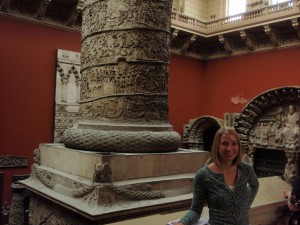
Alli morphed by a gargantuan columnNo caption needed.
As a whole, we felt that this museum showed more socio-cultural exhibits than the rigid British Museum and National Gallery. The 20th Century exhibit showed anything from an iMac to early cell phones. It included a section about technology as an astestic, featuring a pink vacuum cleaner from the 1970s. This museum tended to show more “everyday life” items rather than royal jewels and strictly upper class items that are less easy to relate to. Even the jewelry exhibit included less elaborate pieces, such as funerary rings, that did not necessarily belong to royalty or a famous name. These items weren’t just “dug up from the ground” and put on display, but they were placed in a better context.
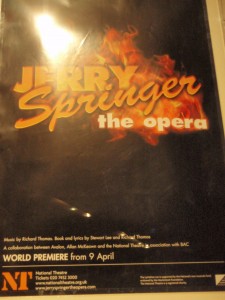
No caption needed.
Additionally, the V&A seemed to be more “British,” containing the most number of galleries dedicated to English artifacts and history. They had 13 rooms entitled “British Galleries: 1760-1900” whereas the British Museum only had 2 rooms and the National Gallery had 4. It is interesting that these two museums are considered “national” museums and yet they have the least amount of national artifacts.
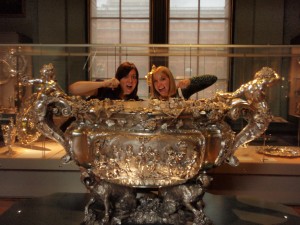
Sarah and Alli drinking from the giant punch bowl
Tags: Alli · Chelsea · Museums · Sarah
August 30th, 2009 · 1 Comment
A plaque in the British Museum tells us, “Enlightened men and women believed that the key to unlocking the past and the mysteries of the universe lay in directly observing and studying the natural and the man-made world. Their passion for collecting objects, from fossils and flints to Greek cases and ancient scripts, was matched by their desire to impose order on them, to catalogue and to classify”. Let’s put on our mathematics hats on and visit the transitive property for a second. Math isn’t my strong suit but I think it works. People from the Enlightenment believed in prospering and discovering more about the world around them by collecting ideas from others. The English people have prospered and discovered more about the world around them by collecting ideas (and goods as demonstrated in the museum itself) from others. Can we not substitute the English for the people in the Enlightenment then? By my understanding of the transitive property we can. And if we do that, the British Museum puts the British people on display fantastically.
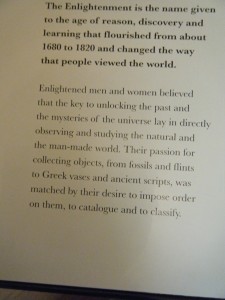
Signage in the Enlightenment room
Our class seems to be throwing around ideas about how British the British Museum really is. I’ll try to give the topic as good a go as the rest of the class has done. I think the British Museum is actually the perfect name for a museum that showcases a country that has borrowed or stolen ideas from other cultures from which they can prosper by showcasing artifacts that they have borrowed or stolen from other cultures from which they prosper. That’s an incredibly wordy way to say that the name fits because Britain itself is a lot like the exhibits the museum has: a forum of borrowed ideas and items. Not convinced? Look around at the people who are at the museum. First off, it’s incredibly crowded. Good luck getting through to see the Rosetta Stone, Cleopatra’s artifacts, the Easter Island statue, or the dancing Shiva. The crowd doesn’t simply consist of British people admiring what they have taken from other cultures. Walk through the crowd and listen to all the different languages that surround you. Chinese, Japanese, Russian, French, something that sounds like Hebrew, and, of course, English- you name it, you’ll probably hear it. Aware of this, the museum offers all of those languages on all of its important postings so that everyone who visits can navigate the museum as easily as possible (which, due to its size, isn’t very possible despite the amounts of maps available for use). As soon as you step out of the museum, you see a hot dog stand and a macadamia nut vendor and feel very much in ‘British’ London. But look around at the surrounding shops and restaurants on surrounding streets. Again, there are multiple Chinese, Thai, Indian, French, and Middle Eastern places all within walking distance (if not eyeshot) of the museum. Not only are these populations present in Britain today but they have also been influential in British history for quite some time. We’ve discussed in group discussions how today’s Britain has been shaped by the colonies it’s imperialized, by the countries it’s traded with. For years, Britain has been formed by borrowing ideas from other countries- it only makes sense that the British Museum would be composed of the work of other countries as well. In that vein, the British Museum is incredibly British in my mind.
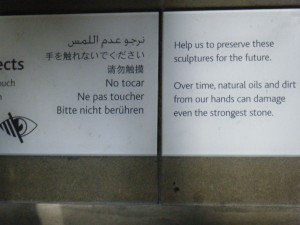
Just some of the languages listed on a sign reminding us not to touch what's on display
So if the museum is British and thus displays the British quite intensely, I’m interested in what the museum wants us to deduce from the exhibits. What does the museum think is British and how does it want to display the culture to us? Clearly, it wants visitors to see a culture that is rich in intellect, has an appreciation for the arts, and is open and proud of its diversity. I would argue that that is in line with what Britain wants to portray itself as to the world: a welcoming place in which diversity can thrive. As our last class discussion demonstrated, the success of that endeavor is debatable to say the least. But the museum at least strives to guide everyone through its walls in as equal a way as is possible by listing so many different languages on its signage. Maybe if we look hard enough, that same helping hand might be around the city as well. Maybe. Just don’t get swept away in the crowd while trying to spot such a sign.
Tags: Audrey · Museums
There are a total of eight Royal Parks within all greater London: St. James’s Park; The Green Park; Hyde Park; Kensington Gardens; Richmond Park; Greenwich Park; The Regent’s Park and Bushy Park. Thus far, I have visited three of these: St. James’s Park; Greenwich Park and The Regent’s Park. Each park was very different, yet shared a similar history.
St. James’s Park, originally created by King Henry VIII as a personal deer park for hunting, is located in Westminster. The park has been remodeled several times, including once for King Charles II in the 1600’s and again in the first half of the 1800’s by John Nash. The closest tube stops include Piccadilly Circus, Charing Cross and, of course, St. James’s Park.
This park is absolutely massive. You could easily spend an entire day here. Perhaps the most interesting feature of this park is its wildlife. There were waterfowl of all kinds paddling and preening in around the long lake that stretches through the park and placards along the way that discussed each species. The asphalt walkways circling the lake contain markers that indicate that the Princess Diana Memorial Walk trails through the park. With all the flora and fauna found inside St. James’s Park, it only seems appropriate to commemorate one of Great Britain’s most beloved members of the royal family here, amidst such beauty.
St. James’s Park is a popular spot for tourists and locals alike. There were many families, especially, snapping pictures of the scenery, but also native Brits jogging or enjoying lunch or a book in the park. What I did find interesting was that there were very few non-whites in the park. I remember seeing one tourist family of what appeared to be an Indian descent inside the park, posing for family snapshots by a knotty tree, and a two black women with strollers and little, skipping girls around the age of five, who walked along the sidewalk on the outskirts of the park, but never entered it.
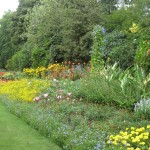


Greenwich Park is equally interesting. We walked through this park on our way to The Royal Observatory, which is located almost in the center of the park. The Observatory was commissioned by King Charles II (see hyperlink above) in 1675 and was designed by Christopher Wren, the architect who was responsible for countless famous buildings around London including St. Paul’s Cathedral and others circa the Great Fire of 1666. The park is inaccessible via the tube, but many buses such as the 188 and 53 run through Greenwich at frequent intervals.
This park, which is divided by the Prime Meridian features much more open space than either St. James’s or The Regent’s Park. There are large expanses of lawns – slightly browning in areas – with trees dotting the landscape throughout, but no fences, hedges, walls or other structures that create intimate spaces within the park. As we walked through the park I noticed many families and couples strolling through the park, and several joggers. There was a friendly yet rather skinny dog sniffing around the sneakers of several students. He carried a ball in his mouth and seemed to plead with his icy blue eyes for a playmate. He wandered around without direction and I wondered if he was blind, or homeless, and watched the ribs shift under his taut skin.
The abandoned dog, the slightly sunburned grass and the lack of flora cast a feeling of melancholy upon me as I walked through the park. I didn’t feel joy or peace in Greenwich Park as I did in St. James’s or The Regent’s Parks. Even the view of the city from the top of the hill upon which the observatory is situated depressed me. It is a view full of skyscrapers, power plants, power lines, smoke stacks no longer in use. When I am in the city for too long, I crave green space, but in Greenwich Park, I found myself preferring the city.
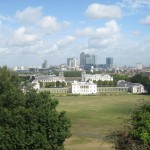
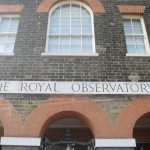
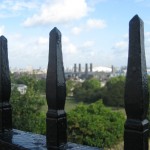
The Regent’s Park, located between Paddington and Camden Town, is accessible via several tube stops, including; Marylebone, Great Portland Street and, of course, Regent’s Park. The park was originally another of King Henry VIII’s deer gardens (see hyperlink above) and features the Queen Mary’s Garden, an area of the park blooming with over nine thousand begonias.
The Regent’s Park is one of the most stunning places, if not the most, I have been lucky enough to visit in my life. The walkways reach out through rows of shaped cylinders of shrubbery and tall hedges line the walkway, creating walls of green that flank beds of bright flora. Fountains pour out clear water that glints in the sun, cascading like icicles ripped from rooftops in the winter. There are areas reserved strictly for children, areas with cafes, an outdoor amphitheatre and a community sports and recreation centre. The overall feeling that I had being in the park was one of peace and serenity. Car horns, sirens, the pounding of joggers’ feet and the wails of children with scraped knees or simply a poor temperament could not be heard in the near silence of the park. For one who is quick to grow weary of the London hustle-bustle, The Regent’s Park serves as the quintessential getaway.
All of the Royal Parks I have visited thus far each have their own distinguishing characteristics, and a unique essence. But don’t take it from me. Hope on the tube and go find yourself some green.
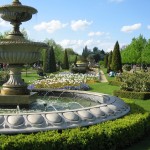
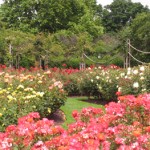
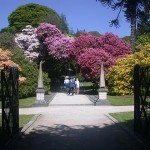
Tags: Anya
As I continue to explore London more and more I realize just how vast and widespread this place is. Before our class took a walk through Southwark on Friday morning I realized I had not even been close to where we were that day. There is so much to do here and it would take years and years to truly get a sense of what all London has to offer. Over the past few days i’ve been trying to conquer as much as London as possible. During Friday and Saturday I spent most of my time conquering museums and theaters.
I’ll start with museums. On Friday after our walk of Southwark I headed out to lunch with a fairly large group of people. After our lunch I had a hard time shaking off a bout of sudden tiredness. I figured a trip to the Tate Modern would remedy this. I’m not afraid to admit that I was wrong.
Modern art is an interesting beast. As much as I’ve tried still I have a hard time understanding it. Despite this statement in no way am I critical or judgemental of anyones work. As someone who has basically no experience/background with modern art I have no right to say anything negative about someone’s art, I simply just can’t grasp it. Walking around through the first few galleries of the Tate Modern I wandered, I sat, I stared, but still found nothing. I asked Brandon his opinion about some of the artwork and this helped. Talking to someone who has taken classes in the subject and is passionate about it was definitely a good choice and I learned a lot but after some more musings I still found nothing. Perhaps it was the drowsiness, perhaps it was the absurdly sexually explicit video I witnessed in one section of the museum but soon after entering I realized I had seen enough of the Tate Modern.
Since many other people in our class had seen the Cabinet War Rooms and the Churchill Museum earlier in the week I figured the afternoon would be a great time to see both of those. This time I was right. From the moment I entered the doors I had a feeling I would enjoy walking through this dungeon of secrets. Although I would never want to be stuck down there for long periods of time I was amazed at how well intact the war rooms were. As I walked through the narrow hallways I had an eerie feeling that I was sent back in time to the early 1940’s when Churchill used the space frequently during the Blitz to hold meetings and conduct secret business. My favorite part of the war rooms was the tiny room that Churchill put 11 secretaries in. According to the audio tour despite the close proximity to each other he expected immaculate work from every single one of these women and did not hesitate to fire them if they were not pulling their weight.
After the tour of the War Rooms I spent a bit of time in the Churchill museum before my fatigue caught back up to me. I decided it would behoove me to head back to my room and rest for a little bit before preparing for the performance of “Troilus and Cressida” that we would be attending that night at the Globe Theatre.
After getting off at the St. Paul’s tube stop and scurrying across the Millennium Bridge Brandon, Aidan and I made it to the performance about ten minutes early. Just enough time to catch our breath and prepare for the real ordeal: standing for three hours. Despite my concerns going into the performance in retrospect being a “groundling” was not that bad at all. My feet were certainly a little uncomfortable by the end of the night but being so close to the action on the stage certainly made up for that. I really enjoyed the performance overall. Matthew Kelly’s portrayal of Pandarus was phenomenal and Paul Hunter (Thersites) left me in stitches for most of the night. While reading the play beforehand I did not enjoy it all that much. It’s amazing how easily and completely transformed a play can become however once performed versus just read. My experience at the globe was great and I hope to go back and see another show before I leave London.
Walking back over the Millennium Bridge that night to the beautiful view of St. Paul’s across the Thames I concluded a few things. The first being that London is even more stunning at night than it is during the day. The second being that i’m not going to enjoy everything I see here in this city and I have to come to terms with that. I have been lucky so far on this trip that very few things have disappointed me. I realize I have to be ready to be surprised both negatively and positively with encounters I have, places I go and things I learn. Like everything else in life London is not perfect nor should it be.
Tags: Henry · Museums · Theatre
It’s kind of difficult for me to attempt to describe what the Notting Hill Carnival was like earlier today. It was a complete and utter attack on all of my senses. I could feel the bass drum of the music reverberating throughout my body. I could smell the cooking smoke coming from the food-covered oil-drums-turned-grills. I could taste the spicy, tangy, smoky flavors of my amazing jerk chicken lunch. I could see the countless Jamaican and Trinidadian flags, Bob Marley posters, brightly colored clothing, vividly dyed pink-and-blue hair, and people of every race, religion, age, and size.
I realize that most of the people I saw at the carnival are probably tourists. I know that I heard at least four or five different languages, but I don’t think that it took away from the experience of the festival very much. Yes, there were places where you could buy “Imported Jamaican whistles” and Notting Hill Carnival 2009 t-shirts (probably both imported from China…), but the vendors in the center of it all seemed to be, to my unknowing eyes, pretty authentic. Salt fish, jerk chicken, curry goat, and plantains featured heavily on almost every food stall’s menu. Granted, there was the occasional Piccadilly Whip ice cream van and crepe booth, but in this day-and-age, I think that most everyone expects to be able to buy a soft-serve cone at an outdoor festival!
The thing that impressed me most about the carnival was how far things have come. When this festival started, it was a protest against the Police force for randomly stopping and searching young black men for drugs and other illegal substances. Apparently the Notting Hill Carnival has been so controversial between the Afro-Caribbean population and the Metropolitan Police that the bobbies tried to have it shut down until just a few years ago. Today I saw a large number of Police attendance, albeit they were doing their jobs, but they seemed to be having a good time. I saw one officer who looked like he’d been in the force when riots were at an all-time-high bobbing his head and swaying his hips to the infectiously happy music. Others were only too happy to oblige tourists by posing for pictures and allowing them to pet their horses. Despite the large number of tourists, I think that this was the best example of cooperation and the new ethnically diverse English identity I’ve seen since I’ve been in London. Thoughts?
Tags: Kelley


























